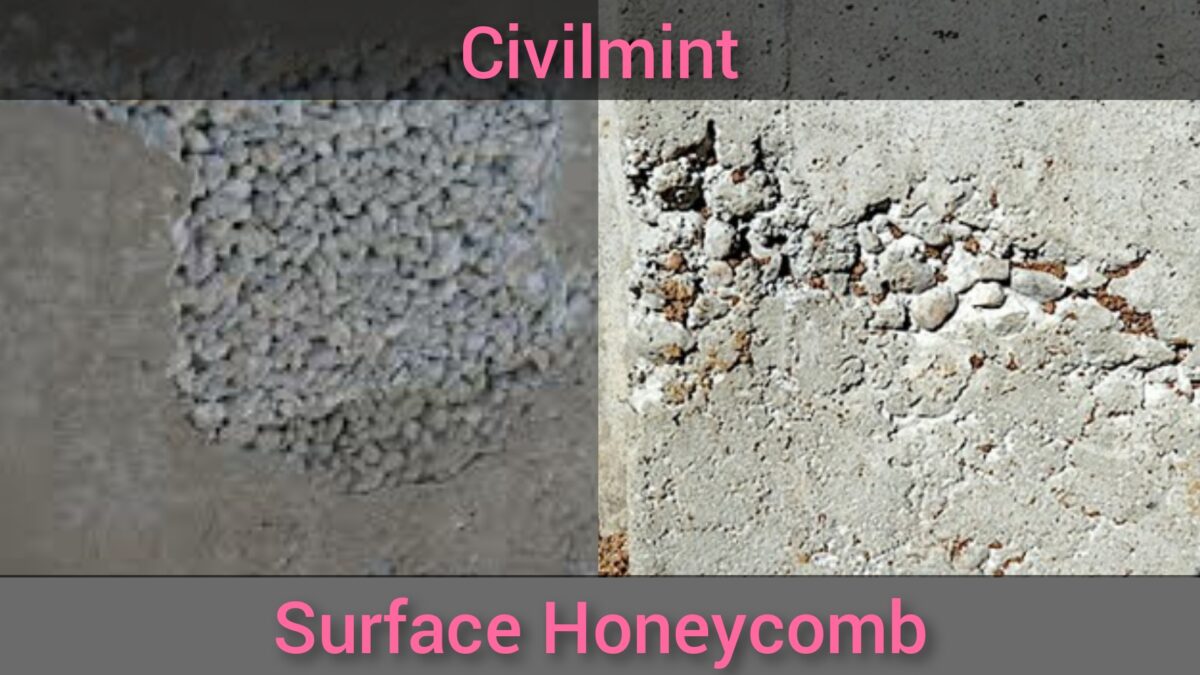Table of Contents
What Is Honeycomb In Concrete?
Honeycomb define as rough, pitted surfaces or voids in concrete resulting from the incomplete filling of the concrete against the Formwork.

The surface looks very rough with a void and gap between concrete and reinforcement. It resembles the Honeycomb.
Honeycomb is a very serious problem that not only decreases the strength of concrete but also makes the reinforcement vulnerable.
Types Of Honeycombs In Concrete
1. Surface Honeycomb:

This type of honeycomb is visible on the surface of the concrete and can be easily detected by visual inspection. Surface honeycombs are usually caused by inadequate vibration, insufficient compaction, or improper formwork.
2. Structural Honeycomb:

This type of honeycomb is located inside the concrete structure and cannot be easily detected by visual inspection. Structural honeycombs are usually caused by improper concrete placement, insufficient consolidation, or improper mix design.
Causes Of Honeycombs In Concrete
The Honeycomb is caused by improper workability of concrete using stiff concrete which is hard to place.
1. Improper Vibration
At the time of concreting if the vibrator needle does not cover all the concreted areas then a honeycomb will be formed. Accessive vibration also makes grout leak through the formwork and leaves the aggregates to settle down.
2. Improper Workability
Too much stiff concrete will not allow it to spread properly forming voids, and adding more water can cause segregation of aggregates creating honeycomb structures.
3. Free Fall Of Concrete (Placement of concrete from height)
When we pour concrete from a certain height If there are obstructions like heavy reinforcement while concreting, then having unrestricted free fall may cause honeycombing in concrete.
4. Gap In Formwork
At the bottom of formwork and in corner joints and in concrete joints if there are gaps then Honeycomb may form due to leakage of grouts and leaving more coarse aggregates.
5. Improper Covering Of Reinforcement
If the reinforcement touches the formwork then reinforcement will appear after the removal of the formwork.
6. Oversize Aggregates
Oversized aggregates do not mix properly and the freeflow of concrete in the reinforcement area causes honeycombing.
7. Reinforcement At Junctions
Due to overcrowded reinforcement at the junction points of beams and columns, it is difficult to vibrate the concrete in this area so honeycomb may become in this area.
Effects Of Honeycombs In Concrete Structures
1. Reduced strength
Honeycombs weaken the concrete structure by reducing its overall strength. The presence of voids and cavities create stress concentrations in the concrete, which can lead to cracks and ultimately, failure of the structure.
2. Decreased durability
The presence of honeycombs also reduces the durability of the concrete structure. Honeycombs create pathways for water to seep into the concrete, which can cause corrosion of the reinforcing steel and ultimately, structural failure.
3. Increased permeability
Honeycombs increase the permeability of the concrete, which can lead to moisture and water penetration. This can cause damage to the concrete, as well as the embedded steel reinforcement.
4. Bad Appearance
Honeycombs can also affect the appearance of the concrete surface. The exposed honeycombs can create an uneven and rough surface, which can be unsightly and difficult to finish.
How To Prevent Honeycomb In Concrete
Here are some tips to prevent honeycombs in concrete structures.
- The proper needle size of the vibrator should be chosen. We should have different sizes of the needle for beam, column, and footing, etc. Vibration time should be 5 to 15 seconds while inserting a needle in the concrete.
- The water-cement ratio should within the required limit otherwise segregation may take place or concrete can become too stiff.
- Fresh Concrete should be poured before the initial setting time to maintain the water-cement ratio.
- Spacers should use to provide proper concrete cover.
- Use Builder Clamp to avoid bulging in the formwork.
- Limit the free fall height of concrete to 1500 mm where there are more obstructions for concrete pouring.
- At the beam and column junctions, higher grades of concrete should use to increase the quantity of cement in the concrete.
- Proper aggregates should use as specified otherwise if it is not as specified it can be stuck in steel and concrete will not flow properly.
Repair Of Honeycomb In Concrete
To repair honeycomb in concrete, you must remove the affected areas and fill them with fresh concrete. The process involves chipping away the affected concrete, cleaning the area, and filling the voids with fresh concrete.
Sometimes, you may need to add additional reinforcement to ensure the structural integrity of the repaired area. Repairing honeycomb is important because it prevents further damage to the concrete structure.
Sum Up
Honeycomb in concrete is a term used to describe voids or gaps that form within a concrete structure, resembling a honeycomb or beehive.
These voids or gaps can significantly affect the strength, durability, and overall appearance of the structure. Various factors can cause honeycombing, including improper placement and consolidation of concrete, insufficient compaction, or the use of inappropriate concrete mixtures.
Incomplete consolidation of fresh concrete causes the voids, cavities, or gaps within a concrete structure that result in honeycomb. The hardened concrete containing areas of air voids or pockets may reduce the structural integrity and durability of the concrete.
